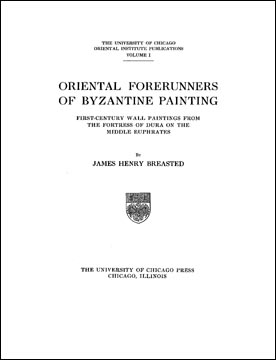OIP 1. Oriental Forerunners of Byzantine Painting: First-Century Wall Paintings from the Fortress of Dura on the Middle Euphrates J. H. Breasted.

Buried in the heart of the Syrian Desert, the city of Dura had been forgotten for fifteen centuries. In this lost city on the outer fringes of the Roman Empire in Asia were thus preserved the only surviving oriental forerunners of Byzantine painting, out of which arose the pre-Renaissance painting of Europe. Dura lies on the Middle Euphrates, in the debatable ground between Syria and the Mediterranean world on the west and Mesopotamia on the east and north. It was the good fortune of the University of Chicago expedition to make the first dash undertaken by Western men after the First World War across this desert region and the newly proclaimed Arab state. After a hasty preliminary inspection for which Breasted and his friends ran up by automobile from the British headquarters at Albu Kamal, they found themselves at Dura with but a single day. Without the protection of the British Indian troops it was not safe to remain at Dura. Therefore, this first publication of the Oriental Institute represents a single day's field work of the expedition. Despite the shortage of time, the field work at Dura developed unique and very prominent documents for the use of historians, archaeologists, and art students because the most important of the wall paintings recorded has since been so seriously damaged that the Oriental Institute's records are now the capital source for knowledge of it. Their chief importance lies in their evident character as cultural links between the Orient and later Europe. The reader who will examine the mosaics from the church of San Vitale at Ravenna (Plate XXII) and compare them with the largest of the Dura wall paintings (Plate VIII), will not long be in doubt that we have in these Dura paintings a part of the lost oriental ancestry of Byzantine art.
- Oriental Institute Publications 1
- Chicago: The University of Chicago Press, 1924
- Pp. 105, 58 figures, 23 plates, 2 maps
- Hardbound 9.00 x 11.75 in / 23 x 30 cm
- Out of print

